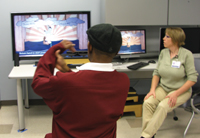|
By Dawn
Brazell
Public Relations
Herbert
Pinckney settles in to punch some
ducks in the video game, Duck Duck
Punch, letting researcher Michelle
L. Woodbury, Ph.D., get him
scanned in to create his avatar
arm.
 Stroke survivor
Herbert Pinckney tries to earn
points on a video game as Dr.
Michelle Woodbury offers
encouragement. Stroke survivor
Herbert Pinckney tries to earn
points on a video game as Dr.
Michelle Woodbury offers
encouragement.
His 11
grandchildren would think the game
way too easy, but for Pinckney
it's Olympic-caliber work. Having
had a stroke about eight months
ago, he struggles to lift his arm.
He's trying to score points by
knocking over a series of ducks on
the screen. The level gets harder
as some seagulls begin flying
across. Woodbury, an occupational
therapist and research director of
the upper extremity motor function
lab in MUSC's Center for
Rehabilitation Research in
Neurological Conditions, allows
him to use his other arm to
assist.
"Bend and get
that duck. Can you get that duck?
That's a tough one," she said,
encouraging his competitive
streak.
Pinckney is making history, both
personally, in regaining lost
mobility in his impaired left
side, and medically. He became the
first participant in a feasibility
study aimed at the development of
the first generation of games
designed to help a segment of
stroke patients for whom very few
therapy options exist.
Woodbury, who
still is recruiting for the study,
praises Pinckney and points out
the huge difference in his ability
since he first started. She said
she's been amazed by early results
that suggest patients are
benefitting more than was
expected.
The innovative
virtual reality system is the
brainchild of an ongoing
collaboration between Woodbury and
the research teams of Larry
Hodges, Ph.D., the endowed chair
and director of the Clemson School
of Computing.
Using a
low-cost motion tracking device, a
stroke patient's real world arm
movement is translated into
virtual world arm movements.
Patients see the avatar arm from
the same perspective as they see
their own arm and are able to
control the avatar arm with their
own arms. Although the patient's
actual arm movement may be small,
the avatar arm responds with full
reaching motions in the virtual
world to play an interactive
virtual game.
Woodbury
controls what the ratio of real to
virtual arm movement is based on
the patient's degree of
disability. For example, this
threshold may be set so that a
patient may need only five degrees
of voluntary elbow extension to
control the avatar. As the patient
improves, this threshold can
change to require 10 degrees.
Patients are
given the illusion of performing
full normal reaching movements and
accomplishing specific tasks. This
is exciting given new research
that is showing the advantage of
activating and reorganizing the
neural networks in the brain that
have been affected by illness and
injury to enhance rehabilitation,
she said.
"This is never
in place of a therapist," she said
of the game, "but this gives a
therapist another tool for the
toolbox. The virtual enviroment
offers things the real world
can't. In the virtual world, we
make the world easier for them."
 The video game
simulates full range of motion
for a stroke survivor with
limited motion. To see a video,
visit http://bit.ly/MUSC_Virtual_Reality. The video game
simulates full range of motion
for a stroke survivor with
limited motion. To see a video,
visit http://bit.ly/MUSC_Virtual_Reality.
Eventually,
therapists will be able to send
their patients home with a Kinect
game that will challenge them in a
fun way and reinforce therapy
being done in the clinic. She has
enjoyed collaborating with Hodges
and his group, although they've
had to be patient with each other
at times in translating the
respective jargon of their fields.
Woodbury also
is working with a group of 10
volunteers from the gaming
community for the study and has
been amazed by their contributions
about how to make the game more
entertaining. They are
incorporating their comments to
improve future generations of the
game.
Hodges said his
expertise is in the design,
implementation and testing of
virtual environment software.
Teaming with application content
experts to understand and
contribute to solutions that
support their clinical goals is
both challenging and rewarding.
"Many of my
graduate students chose to study
computer science with me because
they wanted to build solutions
that address real-world problems."
He has been
doing collaborative research with
clinical partners since 1993 and
has supervised the design and
implementation of virtual
environments for use in the
treatment of balance disorders,
anxiety disorders, post-traumatic
stress disorder in Vietnam
Veterans and for pain distraction
with pediatric cancer patients. He
has talented graduate students who
are committed to building
computing systems that have a
positive impact on society, he
said.
For his team
that means seeing if their virtual
environments are helpful to
clinicians and resolving the
numerous technical issues that
crop up.
"Building real
systems causes us to address
computing challenges in animation,
geometric modeling, motion
tracking, artificial intelligence,
software engineering and real-time
rendering."
It's all worth
it, though.
"The continued
decline in cost and increase in
performance of computers, tablets,
smart phones and interface devices
such as the Kinect is opening up
vast opportunities for new
clinical collaborations."
 Dr. Michelle Woodbury Dr. Michelle Woodbury
Woodbury
certainly is thrilled.
It enhances her
ability to use her extensive
stroke rehabilitation experience
and is the culmination of a type
of project she has always wanted
to do. Her study pairs
occupational therapy with use of
the game and in three weeks,
Pinckney just about doubled his
movement range.
The majority of
the 795,000 people annually
affected by stroke cannot resume
daily activities because of the
impairment in their motor
abilities in their upper
extremities. Current
neurorehabilitation occupational
and physical therapy programs
incorporate intensive, repetitive
practice of meaningful tasks to
improve this movement and
function.
Task-practice
interventions are based on
contemporary neuroscientific
studies showing that high-dose
repetitive practice of the tasks
of reaching, grasping and
manipulation tasks improves the
excitability of the damaged cortex
and can improve recovery.
Unfortunately,
it is estimated that only about 25
percent of stroke survivors have
enough function to do this type of
therapy. Virtual reality can
change that scenario.
She grins.
Plus, they get to punch ducks.
"They love it,
and they think it's fun. It's fun
to do something they can't do
anymore."
For
more information:
Visit http://www.SCresearch.org
to find out more about the study:
A Virtual Reality Environment for
Post-Stroke Upper Extremity Motor
Rehabilitation.
|



 The video game
simulates full range of motion
for a stroke survivor with
limited motion. To see a video,
visit
The video game
simulates full range of motion
for a stroke survivor with
limited motion. To see a video,
visit 